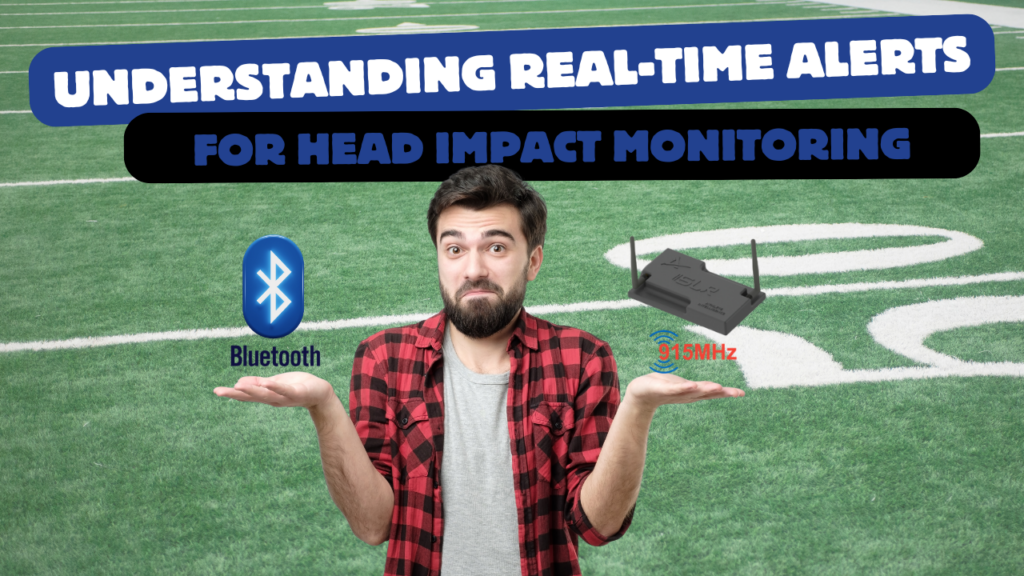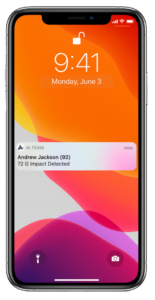Understanding Real-Time Alerts in Head Impact Monitoring
 Why 915 MHz Outshines Bluetooth For Impact Data Transmission
Why 915 MHz Outshines Bluetooth For Impact Data Transmission
In the fast-paced world of sports, safety is paramount—especially when it comes to monitoring head impacts in high-contact activities like football, hockey, rugby and lacrosse. Real-time alerts on big impacts can be game-changing, enabling coaches, athletic trainers, and medical staff to make quick decisions that protect players. But to make this happen, accurate and rapid data transmission is essential. Here, we’ll explore two of the most common data transmission methods used in head impact monitoring: 915 MHz and Bluetooth, and discuss why 915 MHz is the clear leader for transmitting data instantly, reliably, and across longer distances.
Why Real-Time Alerts Matter
Real-time alerts are a key feature of advanced head impact monitoring systems. These alerts, generated after a significant impact, provide immediate feedback to sideline staff, helping  them respond proactively. Timely alerts can make a difference in preventing potential injuries, especially those associated with repetitive head impacts.
them respond proactively. Timely alerts can make a difference in preventing potential injuries, especially those associated with repetitive head impacts.
Comparing 915 MHz and Bluetooth for Real-Time Data Transmission
Both 915 MHz and Bluetooth serve as options for data transmission in head impact monitoring, yet they are far from equal when it comes to delivering reliable real-time alerts. Here’s why:
1. Transmission Range
- 915 MHz: Designed specifically for extended range, 915 MHz operates on a lower frequency, allowing data to travel much farther without interruption. This means coaches and athletic trainers can receive impact alerts even if the athlete is far across the field, ensuring consistent communication regardless of distance.
- Bluetooth: Bluetooth, while effective for short-range connections (typically up to 30-50 feet), loses reliability quickly as distance increases. In a large field environment, this can create gaps in communication, causing alerts to fail to reach sideline staff.
2. Transmission Speed and Reliability
- 915 MHz: Known for fast, continuous data transmission, 915 MHz is ideal for transmitting real-time data because it can quickly send and receive data even in complex environments with obstacles. This helps ensure that alerts are sent the moment a significant impact occurs.
- Bluetooth: Bluetooth struggles to transmit data as rapidly or continuously as 915 MHz. This is especially true in environments with interference, where transmission delays or data loss can occur. In a high-stakes setting, these lags can mean that alerts are delayed or missed entirely, compromising safety.
3. Power Efficiency
- 915 MHz: While both systems require power, 915 MHz is optimized for longer battery life in real-time monitoring devices. This efficiency allows sensors to run reliably throughout practices and games without frequent recharging or downtime.
- Bluetooth: Bluetooth can consume significant power in continuous monitoring mode, resulting in more frequent battery drain. This creates additional challenges in ensuring devices remain functional during long practices or extended games.
Real-World Impact of Data Transmission Failures
In head impact monitoring, missed or delayed alerts due to poor data transmission can have serious consequences. Imagine a scenario where an athlete receives a high-impact hit, but the Bluetooth-based system fails to alert the coach immediately due to its short range or interference. The athlete could unknowingly remain at risk, lacking the immediate attention they need.
915 MHz offers a solution to this problem by delivering alerts over greater distances with higher reliability, reducing the chance that significant impacts go unnoticed.
Why 915 MHz is the Superior Choice
For athletic organizations and teams serious about player safety, the choice between 915 MHz and Bluetooth is clear. While Bluetooth may work in low-stakes or recreational settings, it falls short in the rigorous, high-impact environment of competitive sports. With its longer range, faster and more reliable data transmission, and efficiency, 915 MHz ensures that real-time alerts are delivered consistently, helping coaches and trainers act quickly to safeguard players.
As head impact monitoring technology advances, prioritizing reliable data transmission methods like 915 MHz will continue to be essential for optimizing player safety. Real-time alerts can only be as effective as the technology behind them—making 915 MHz the clear leader in keeping athletes safe on the field.
About Athlete Intelligence
Athlete Intelligence is a head impact monitoring data analytics subscription service for sports teams. We combine wearable technology with actionable insights to provide summarized reports that highlight player performance and safety improvement opportunities. Athlete Intelligence offers head impact monitoring and sensor technology services to youth, high school, and college-level programs. For more information on Athlete Intelligence, please visit: www.AthleteIntelligence.com
Have questions about Real-Time Head Impact Monitoring Technology? Submit them here:
[hubspot type=”form” portal=”2897208″ id=”14ed8e08-9f7e-4b49-93bc-00c0aaa1d387″]